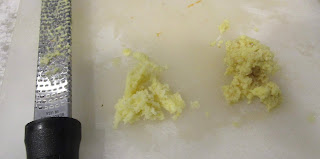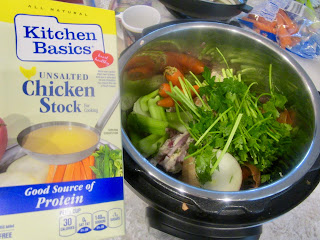Fortunately, I've always kept a good stock in the freezer and pantry. I love making homemade freezer meals so I have easy scratch made dinners most nights. Sometimes those meals are just a starter - like marinated chicken ready to thaw and roast or it's a complete meal that just needs some fresh vegetables or a salad to pair with it.
This week I wanted to use up a pack of frozen grilled chicken that I had. I marinate chicken cutlets (thighs or breasts) overnight, grill, slice up, and then freeze it in vac sealed bags - when thawed, it's not quite as good as fresh off the grill, but it is still very good and you can't beat the convenience of having it on hand to add to salads, pastas, etc.
 I'm using a pack of chicken I marinated in Grill Mates Mesquite marinade, which I normally use for chicken fajitas. I've wanted to try using it for burritos because the hubs loves burritos, so that's what I made this week.
I'm using a pack of chicken I marinated in Grill Mates Mesquite marinade, which I normally use for chicken fajitas. I've wanted to try using it for burritos because the hubs loves burritos, so that's what I made this week. I started out by doing what I normally do for chicken fajitas, which is to sauté 1-2 onions with 2 bell peppers in olive oil with some salt and pepper. Once the peppers are cooked down, I just add the thawed chicken and and let it cook a little longer until the chicken is warmed through. If I was just making chicken fajitas, this is the mix I'd use for those.
Since I was making burritos, I wanted to do a rice and bean component. I made a variation on a salsa rice side dish that I do and I purposely made a large batch because I knew it would freeze well.
Mexican Rice, 10-12 servings
1 large onion, chopped
2 tablespoons olive oil
1 1/2 cups white rice (can also use quinoa, brown rice, etc - just adjust cook times and amount of chicken stock accordingly)
2 14.5 ounce cans fire roasted tomatoes with green chilis (or any diced tomato)
2 1/2 cups low salt chicken stock
1 1/2 teaspoons chili powder
1 1/2 teaspoons cumin
1 12 ounce bag frozen corn
1 15 ounce can black beans, rinsed
1 bunch cilantro, rinsed and chopped
juice of 1 lime
salt and pepper
First of all, don't let the amount of this recipe daunt you. It freezes great and then you have it on hand for a quick side dish or to make more burritos.
If you like a spicier rice, feel free to add chopped jalapeño, red pepper flakes, or cayenne pepper as you like.
In a large 4 quart or larger pan over medium heat, sauté the onion in the olive oil with a pinch of salt until the onion has a softened and become translucent. Add the rice and stir to coat the rice evenly in the oil, letting the rice toast 2-3 minutes. Add the 2 cans of tomatoes, the chili powder, cumin, and chicken broth to the pan, give it a good stir and turn the heat down to a simmer. Cover the pan and let it simmer for about 15 minutes, giving it a stir from time to time. Add in the bag of frozen corn, stirring, and let it simmer for a few minutes more until the rice is cooked and the liquid has mostly been absorbed. Turn the heat off and add the rinsed black beans; cover the pot and let it sit for a few minutes off the heat to finish cooking. Stir in the cilantro and lime juice; taste for salt and pepper and add as needed.
To assemble the burritos, you need about 6 ounces of shredded cheese (I like using a Mexican cheese blend, but whatever you like on tacos will be just fine) and large burrito style tortillas. I made 4 burritos (dinner for one night, then lunch for the next day for the 2 of us), so I split the chicken/peppers/onions mix between 4 of the large tortillas, topped them off with some shredded cheese, and then about 2 spoonfuls of the Mexican rice blend.
Just roll them up while the fillings are still warm. I set 2 aside for lunch the next day, and then finished off the 2 for dinner.
I decided to toast the outside of tortillas by adding a little oil into a
 skillet on medium and then adding the burritos to the skillet. I like how this crisps up the outside of the tortilla, plus it also helps the cheese inside the burrito melt.
skillet on medium and then adding the burritos to the skillet. I like how this crisps up the outside of the tortilla, plus it also helps the cheese inside the burrito melt.You do want to keep an eye on these because they will burn quickly - just keep checking them, and flip over as necessary.
I also like to do this when I reheat burritos (usually I just make breakfast ones with egg/cheese/etc in them). I find that I have to put them in the microwave for a minute or two first as the tortilla gets too crisp on the outside before the inside is heated through.
And there we have it...chicken burritos. I mixed some sour cream with some lime juice and lime zest to have to dip these into.
Overall Rating: 7 out of 10. These were very tasty, not too spicy, but definitely not any kind of authentic. Still, it was a welcome change from tacos and I'd make them again.
Ease of Preparation: 6 out of 10. While not particularly difficult, there's multiple steps to making the fillings for these. Having the grilled chicken all ready to thaw and go made this much easier, particularly as I prefer to marinate chicken overnight before grilling.
Will It Freezer Meal? YES! If I hadn't used grilled chicken that I had already frozen, I would have done a bunch of these for the freezer, and will do them in the future. If you make everything fresh, you should make double or triple the amount of burritos and freeze them for easy dinners. I froze the extra rice mixture and then vac sealed them, so I now have that on hand for making burrito bowls or as a side dish for enchiladas or tacos in the coming months.
























































